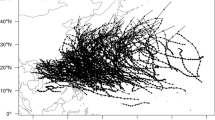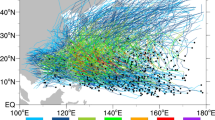Abstract
A nonlinear artificial intelligence ensemble forecast model has been developed in this paper for predicting tropical cyclone (TC) tracks based on the deep neural network (DNN) by using the 24-h forecast data from the China Meteorological Administration (CMA), Japan Meteorological Agency (JMA) and Joint Typhoon Warning Center (JTWC). Data from a total of 287 TC cases over the Northwest Pacific Ocean from 2004 to 2015 were used to train and validate the DNN based ensemble forecast (DNNEF) model. The comparison of model results with Best Track data of TCs shows that the DNNEF model has a higher accuracy than any individual forecast center or the traditional ensemble forecast model. The average 24-h forecast error of 82 TCs from 2016 to 2018 is 63 km, which has been reduced by 17.1%, 16.0%, 20.3%, and 4.6%, respectively, compared with that of CMA, JMA, JTWC, and the error-estimation based ensemble method. The results indicate that the nonlinear DNNEF model has the capability of adjusting the model parameter dynamically and automatically, thus improving the accuracy and stability of TC prediction.
Similar content being viewed by others
References
Buckingham C, Marchok T, Ginis I, Rothstein L, Rowe D (2010). Short- and medium-range prediction of tropical and transitioning cyclone tracks within the NCEP global ensemble forecasting system. Weather Forecast, 25(6): 1736–1754
Buizza R, Milleer M, Palmer T N (1999). Stochastic representation of model uncertainties in the ECMWF ensemble prediction system. Q J R Meteorol Soc, 125(560): 2887–2908
Chen G M, Yu H, Cao Q, Zeng Z (2013). The performance of global models in TC track forecasting over the Western North Pacific from 2010 to 2012. Trop Cyclone Res Rev, 2(3): 149–158
Deng L, Li J, Huang J T, Yao K, Yu D, Seide F, Seltzer M, Zweig G, He X, Williams J, Gong Y, Acero A (2013). Recent advances in deep learning for speech research at Microsoft. In: Proceedings of International Conference on Acoustics, Speech, and Signal. Vancouver: 8604–8608
Elsberry R L (1995). Recent advancements in dynamical tropical cyclone track predictions. Meteorol Atmos Phys, 56(1–2): 81–99
Esteva A, Kuprel B, Novoa R A, Ko J, Swetter S M, Blau H M, Thrun S (2017). Dermatologist-level classification of skin cancer with deep neural networks. Nature, 542(7639): 115–118
Epstein E S (1969). Stochastic dynamic prediction. Tellus, 21(6): 739–759
Gao S, Zhao P, Pan B, Li Y, Zhou M, Xu J, Zhong S, Shi Z (2018). A nowcasting model for the prediction of typhoon tracks based on a long short term memory neural network. Acta Oceanol Sin, 37(5): 8–12
Hamill T M, Whitaker J S, Fiorino M, Benjamin S G (2011). Global ensemble predictions of 2009’s tropical cyclones initialized with an ensemble kalman filter. Mon Weather Rev, 139(2): 668–688
Jeffries R A, Sampson C R, Carr L E, Chu J (1993). Tropical cyclone forecasters reference guide numerical track forecast guidance. Tech. Rep. No. NRL/PU/7515-93-0011
Jin J, Li M, Jin L (2015). Data normalization to accelerate training for linear neural net to predict tropical cyclone tracks. Math Probl Eng, 2015: 931629
Knaff J A, Sampson C R, DeMaria M, Marchok T P, Gross J M, McAdie C J (2007). Statistical tropical cyclone wind radii prediction using climatology and persistence. Weather Forecast, 22(4): 781–791
Krishnamurti T N, Kishtawal C M, LaRow T E, Bachiochi D R, Zhang Z, Williford C E, Gadgil S, Surendran S (1999). Improved weather and seasonal climate forecasts from multimodel superensemble. Science, 285(5433): 1548–1550
Krizhevsky A, Sutskever I, Hinton G E (2012). ImageNet classification with deep convolutional neural networks. In: Proceedings of the 25th International Conference on Neural Information Processing Systems: 1097–1105
Landsea C W, Cangialosi J P (2018). Have we reached the limits of predictability for tropical cyclone track forecasting? Bull Am Meteorol Soc, 99(11): 2237–2243
Leith C E (1974). Theoretical skill of Monte Carlo forecasts. Mon Weather Rev, 102(6): 409–418
Leutbecher M, Palmer T N (2008). Ensemble forecasting. J Comput Phys, 227(7): 3515–3539
Li H, Luo J, and Xu M (2019). Ensemble data assimilation and prediction of typhoon and associated hazards using TEDAPS: Evaluation for 2015–18 Seasons. Front Earth Sci, 13(4): 733–743
Neumann C J, Lawrence M B (1975). An operational experiment in the satistical-dynamical prediction of tropical cyclone motion. Mon Weather Rev, 103(8): 665–673
Peng X, Fei J, Huang X, Cheng X (2017). Evaluation and error analysis of official forecasts of tropical cyclones during 2005–14 over the Western North Pacific. Part I: storm Tracks. Weather Forecast, 32(2): 689–712
Plu M (2011). A new assessment of the predictability of tropical cyclone tracks. Mon Weather Rev, 139(11): 3600–3608
Raddaway B (2012). Newsletter No.130-Winter 2011/12. Available at ECMWF website
Rappaport E N, Franklin J L, Avila L A, Baig S R, Beven J L II, Blake E S, Burr C A, Jiing J G, Juckins C A, Knabb R D, Landsea C W, Mainelli M, Mayfield M, McAdie C J, Pasch R J, Sisko C, Stewart S R, Tribble A N (2009). Advances and challenges at the National Hurricane Center. Weather Forecast, 24(2): 395–419
Saha S, Moorthi S, Wu X, Wang J, Nadiga S, Tripp P, Behringer D, Hou Y T, Chuang H, Iredell M, Ek M, Meng J, Yang R, Mendez M P, van den Dool H, Zhang Q, Wang W, Chen M, Becker E (2014). The NCEP climate forecast system version2. J Clim, 27(6): 2185–2208
Silver D, Huang A, Maddison C J, Guez A, Sifre L, van den Driessche G, Schrittwieser J, Antonoglou I, Panneershelvam V, Lanctot M, Dieleman S, Grewe D, Nham J, Kalchbrenner N, Sutskever I, Lillicrap T, Leach M, Kavukcuoglu K, Graepel T, Hassabis D (2016). Mastering the game of Go with deep neural networks and tree search. Nature, 529(7587): 484–489
Sze V, Chen Y, Yang T, Emer J S (2017). Efficient processing of deep neural networks: a tutorial and survey. Proc IEEE, 105(12): 2295–2329
Toth Z, Kalnay E (1997). Ensemble forecasting at NCEP and the breeding method. Mon Weather Rev, 125(12): 3297–3319
Veigas K W (1996). The development of statistical-physical hurricane prediction model. Final Report, U.S.W.B. Contract Cwb 10966, Travellers Weather Research Center, Hartford, CT, 1996. 19
Wu L, Zong H, Liang J (2011). Observational analysis of sudden tropical cyclone track changes in the vicinity of the East China Sea. J Atmos Sci, 68(12): 3012–3031
Ying M, Zhang W, Yu H, Lu X, Feng J, Fan Y, Zhu Y, Chen D (2014). An overview of the China Meteorological Administration tropical cyclone database. J Atmos Ocean Technol, 31(2): 287–301
Yuan J, Chen Y, Pan Y, Dong J, Luo Y (2017). Improvement of ensemble forecast of typhoon track in the Northwestern Pacific. Marine Forecasts, 34(2): 37–42 (in Chinese)
Zhang R H, Shen X S (2008). On the development of GRAPES-A new generation of the national operational NWP system in China. Chin Sci Bull, 53: 3429–3432
Zhi X, Zhang L, Bai Y (2011). Application of the multi-model ensemble forecast in the QPF. In: Proceedings of International Conference on Information Science and Technology: 657–660
Zhu L, Jin J, Cannon A J, Hsieh W W (2016). Bayesian neural networks based bootstrap aggregating for tropical cyclone tracks prediction in South China Sea. In: Proceeding of International Conference on Neural Information Processing: 475–482
Acknowledgments
This study was supported by the National Key Project of Research and Development Plan of China (No. 2016YFC1401905), the National Natural Science Foundation of China (Grant Nos. 41976163 and 41575107), the Key Special Project for Introduced Talents Team of Southern Marine Science and Engineering Guangdong Laboratory (Guangzhou) (No. GML2019ZD0302), and the Guangdong Special Fund Program for Marine Economy Development (No. GDNRC[2020]050).
Author information
Authors and Affiliations
Corresponding author
Rights and permissions
About this article
Cite this article
Wang, C., Xu, Q., Cheng, Y. et al. Ensemble forecast of tropical cyclone tracks based on deep neural networks. Front. Earth Sci. 16, 671–677 (2022). https://doi.org/10.1007/s11707-021-0931-8
Received:
Accepted:
Published:
Issue Date:
DOI: https://doi.org/10.1007/s11707-021-0931-8




